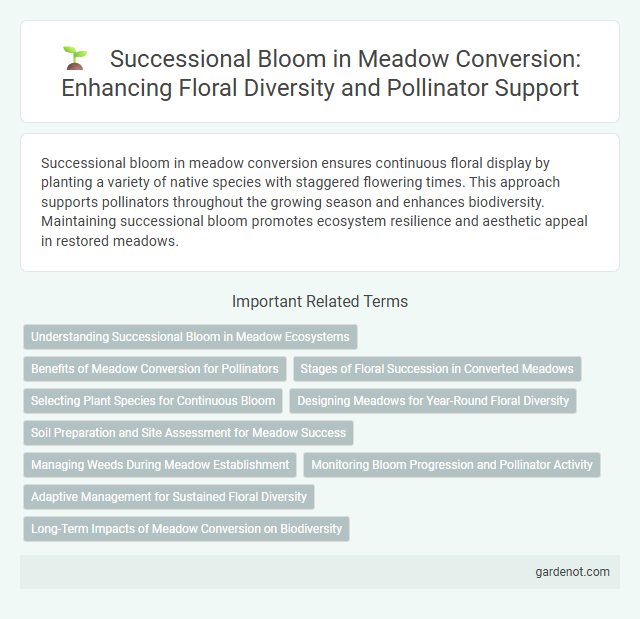Successional bloom in meadow conversion ensures continuous floral display by planting a variety of native species with staggered flowering times. This approach supports pollinators throughout the growing season and enhances biodiversity. Maintaining successional bloom promotes ecosystem resilience and aesthetic appeal in restored meadows.
Understanding Successional Bloom in Meadow Ecosystems
Successional bloom in meadow ecosystems reflects the dynamic progression of plant species over time, driven by natural processes such as seed dispersal, soil nutrient changes, and microclimatic variations. Early-successional species like grasses and wildflowers dominate initial stages, while late-successional species including shrubs and perennial forbs emerge as the habitat matures. Understanding these temporal shifts enhances meadow conversion strategies by promoting biodiversity and ecological resilience through targeted planting and management practices.
Benefits of Meadow Conversion for Pollinators
Successional bloom in meadow conversion creates a continuous supply of diverse nectar and pollen sources essential for pollinators such as bees, butterflies, and hoverflies. This process supports increased species richness and abundance by providing habitats tailored to the life cycles of various pollinator species, promoting ecological resilience. Enhanced floral diversity through successional stages improves ecosystem services including pollination efficiency, directly benefiting agricultural productivity and biodiversity conservation.
Stages of Floral Succession in Converted Meadows
Successional bloom in converted meadows progresses through distinct stages of floral succession, beginning with early colonizers such as grasses and fast-growing wildflowers that stabilize the soil and create habitat conditions. Mid-successional stages introduce a diverse mix of herbaceous perennials and native forbs, which enhance pollinator activity and ecological complexity. Late succession culminates in a diverse meadow dominated by longer-lived species, including native wildflowers and shrubs, that support sustained biodiversity and ecosystem resilience.
Selecting Plant Species for Continuous Bloom
Selecting plant species for continuous bloom in meadow conversion involves prioritizing native perennials and wildflowers that flower at staggered intervals from early spring to late fall. Incorporating species like Echinacea purpurea, Solidago canadensis, and Monarda fistulosa ensures a succession of blooms that support pollinators and maintain ecological balance. Emphasizing diversity in bloom times enhances habitat resilience and maximizes the visual and environmental benefits of the meadow.
Designing Meadows for Year-Round Floral Diversity
Designing meadows for year-round floral diversity involves selecting plant species with staggered bloom periods to ensure continuous successional bloom throughout the seasons. Incorporating native perennials, grasses, and early to late-season wildflowers supports pollinators and enhances ecosystem resilience. Strategic planting of species like Black-eyed Susan (Rudbeckia hirta), Purple Coneflower (Echinacea purpurea), and Goldenrod (Solidago spp.) maintains vibrant floral displays from spring through fall.
Soil Preparation and Site Assessment for Meadow Success
Effective soil preparation and thorough site assessment are crucial for successional bloom in meadow conversion, ensuring optimal nutrient availability and soil structure for diverse plant establishment. Evaluating soil pH, texture, organic matter content, and drainage characteristics helps tailor interventions such as tilling, aeration, or amendment applications to support native wildflower and grass species. Properly prepared soil reduces weed competition and enhances seed germination rates, promoting a resilient, biodiverse meadow ecosystem.
Managing Weeds During Meadow Establishment
Managing weeds during meadow establishment is crucial for promoting successional bloom by reducing competition for nutrients, water, and sunlight. Effective weed control strategies include timely mowing, selective herbicide application, and spot weeding to prevent invasive species from dominating early growth stages. Monitoring weed populations regularly ensures the healthy development of native wildflowers and grasses, enhancing biodiversity and long-term meadow resilience.
Monitoring Bloom Progression and Pollinator Activity
Monitoring bloom progression during meadow conversion is essential for tracking successional bloom phases, which directly influence habitat quality. Detailed observation of flowering stages provides critical data to assess floral diversity, timing, and resource availability for pollinator species. Simultaneous recording of pollinator activity, including species visitation rates and behavior, enhances understanding of ecosystem dynamics and supports adaptive management for pollinator-friendly meadows.
Adaptive Management for Sustained Floral Diversity
Successional bloom in meadow conversion relies on adaptive management to sustain floral diversity by monitoring species composition and adjusting mowing, grazing, or seeding practices accordingly. This approach enhances habitat heterogeneity, promoting a balance between early successional plants and late-blooming species to ensure continuous floral availability. Long-term data collection supports dynamic interventions that respond to environmental changes and maintain ecosystem resilience.
Long-Term Impacts of Meadow Conversion on Biodiversity
Successional bloom following meadow conversion significantly enhances habitat heterogeneity, promoting diverse plant communities that support a wide range of pollinators and insect species. Over the long term, this floral succession fosters increased species richness and ecological resilience, aiding in the recovery of native fauna and stabilizing local ecosystems. Sustained monitoring reveals that maintaining successional stages is crucial for preserving biodiversity and ensuring the continued provision of ecosystem services such as nutrient cycling and soil stabilization.
Successional bloom Infographic

 gardenot.com
gardenot.com